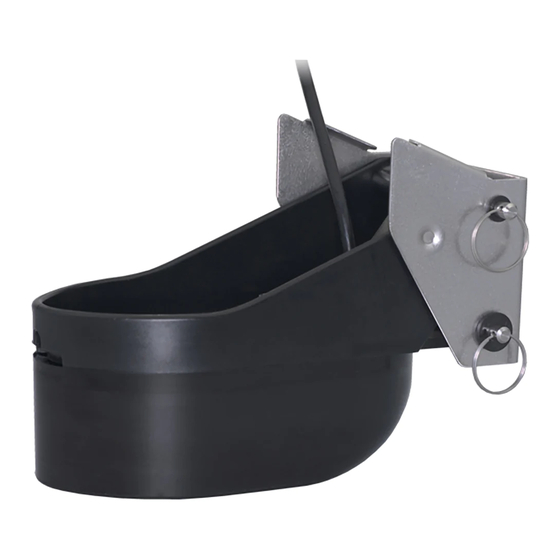Advertisement
Quick Links
OWNER' S GUIDE & INSTALLATION INSTRUCTIONS
Transom Mount 1kW Depth Transducer
Models: TM256, TM260
See cable tag: Part #________________Date___________Freq._____
IMPORTANT:
Please
completely before proceeding with the installation.
These directions supersede any other instructions in
your instrument manual if they differ.
CAUTION: NEVER USE SOLVENTS
Cleaners, fuel, paint, sealants, and other products may
contain strong solvents, such as acetone, which attack
many plastics greatly reducing their strength.
Applications
• Sport fishing vessels
• Good operation up to 30kn (35MPH)
• Not recommended for high-speed inboard powerboats
• Bracket protects the transducer from frontal impact only
Tools and Materials
Pencil
Safety goggles
Dust mask
Saw (some installations)
File (some installations)
Sandpaper (some installations)
Wrench: 3/8"
Electric drill
Drill bits:
Bracket holes
Fiberglass hull
Transom hole (optional) 19mm or 3/4"
Cable clamp holes
hull projection:
0-3cm (0-1/8")
Figure 1. Mounting location on single drive boat
read
these
instructions
4mm, #23, or 9/64"
chamfer, countersink, 6mm, or 1/4"
20mm or 13/16"
Furuno, Raymarine only
3mm or 7/64"
sensor in
"down"
position
transducer
face
parallel to
waterline
15cm (6")
minimum beyond
swing radius
"up"
Masking tape
Marine sealant
Screwdrivers
Straight edge
Stainless steel bolts, nuts, and washers (2 each) 6mm or 1/4"
Zip-ties
Water based anti-fouling paint ( mandatory in salt water )
Mounting Location
General Guidelines
• Mount on the side of the transom where the propeller is rotating
downward (see Figure 1).
• The transducer should be located so that the water passing
over the transducer does not cause a flow disturbance to the
propeller.
• The transducer must be submerged in aeration-free and
turbulence-free water. Do not mount the transducer in an area
of turbulence or bubbles: near water intake or discharge
openings; behind strakes, struts, fittings, or hull irregularities;
behind eroding paint (an indication of turbulence).
• Avoid mounting the sensor where the boat may be supported
during trailering, launching, hauling, or storage.
• Ideally, mount the bracket above the waterline to minimize the
build up of marine growth. It may be desirable to mount the
bracket farther from the keel than recommended in Figure 1.
• Allow enough headroom above the bracket for the transducer to
be raised into the "up" position and the "released" position (see
Figure 2). If there is too little headroom, the support tube must be
shortened (see "Shortening the Support Tube" on page 2).
"Up" position —The bracket is factory pre-set to provide a
vertical travel of 77mm (3") between the "up" and "down"
positions. The vertical travel can be adjusted by moving the
lower latch pin to another set of adjustment holes. With the lower
latch pin in the bottommost set of holes, the support tube
requires 30cm (12") of headroom above the bracket in the "up"
position. The upper latch pin must be inserted through the
topmost holes of the support tube for the transducer to release.
"Released" position —The transducer makes an arc of 110° .
"down"
"released"
Figure 2. TM256
Advertisement

Subscribe to Our Youtube Channel
Summary of Contents for Airmar TM256
- Page 1 OWNER’ S GUIDE & INSTALLATION INSTRUCTIONS Transom Mount 1kW Depth Transducer “up” “down” “released” Models: TM256, TM260 See cable tag: Part #________________Date___________Freq._____ IMPORTANT: Please read these instructions completely before proceeding with the installation. These directions supersede any other instructions in your instrument manual if they differ.
- Page 2 Be sure the drill is oriented transducer parallel to the keel and at right angles to the transom. Drill through any shim(s). Do not drill the holes for the Figure 4. TM256 assembly reinforcement bolts at this time .
- Page 3 3mm (1/8") below the rounded forward end. Tighten the center screw. Figure 7. Transducer angle (TM256 shown) 8. The large diameter line is the hoist line. Tie it to the upper latch pin inside the support tube with a boline knot. The small diameter line is the latch line.
- Page 4 For tube until the latch engages the lower latch pin (see Figure 4). convenient reference, record this information where indicated near the top of page one. AIRMAR 35 Meadowbrook Drive, Milford, New Hampshire 03055-4613, USA TECHNOLOGY CORPORATION www.airmar.com...

















Need help?
Do you have a question about the TM256 and is the answer not in the manual?
Questions and answers